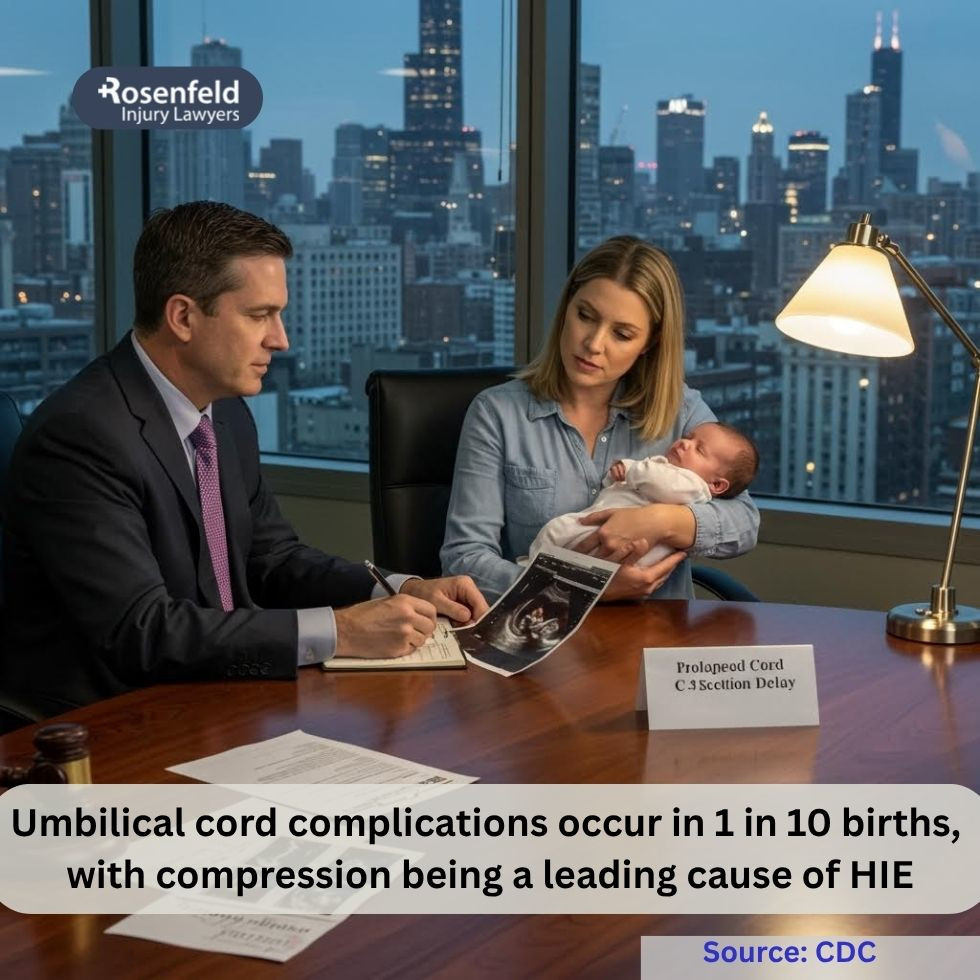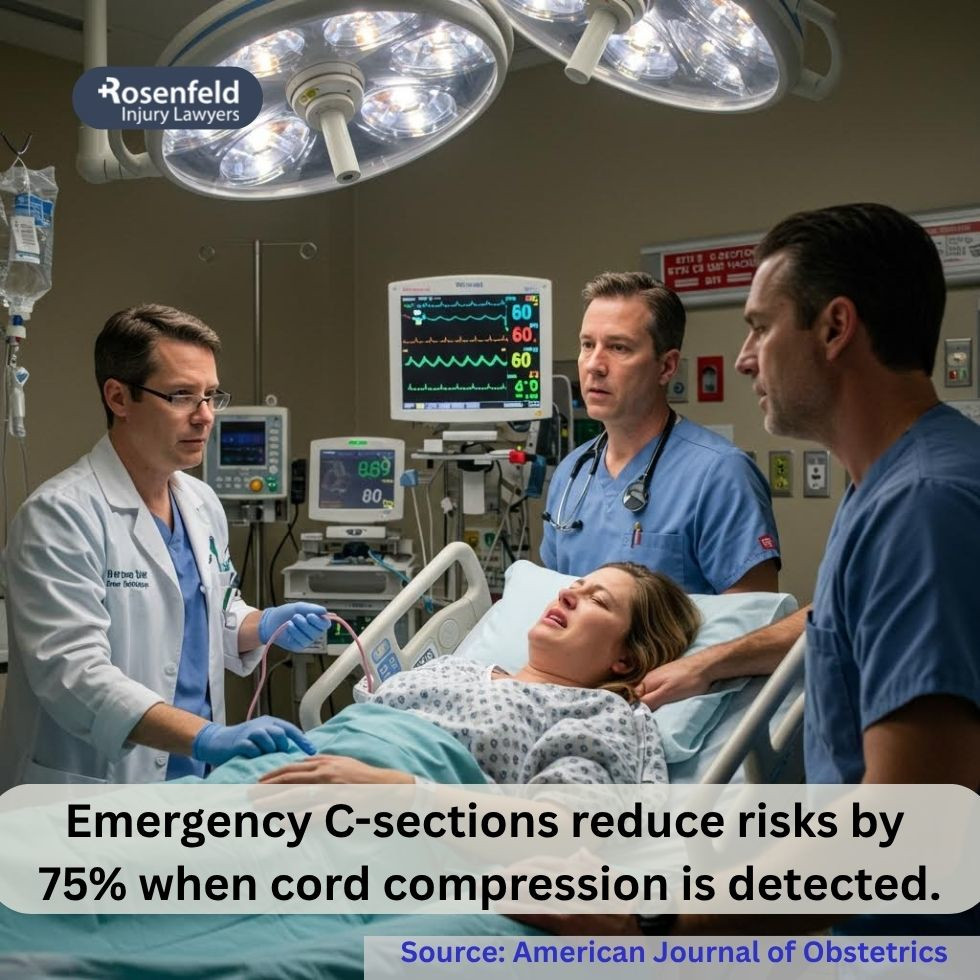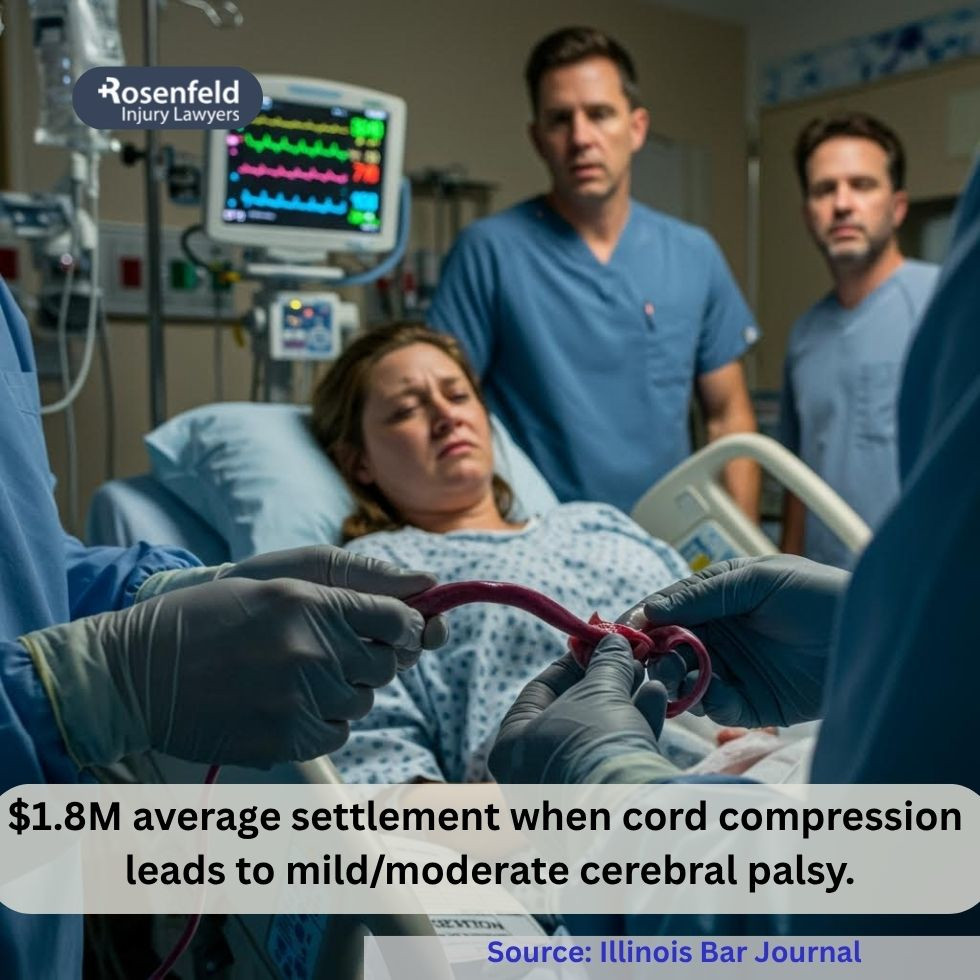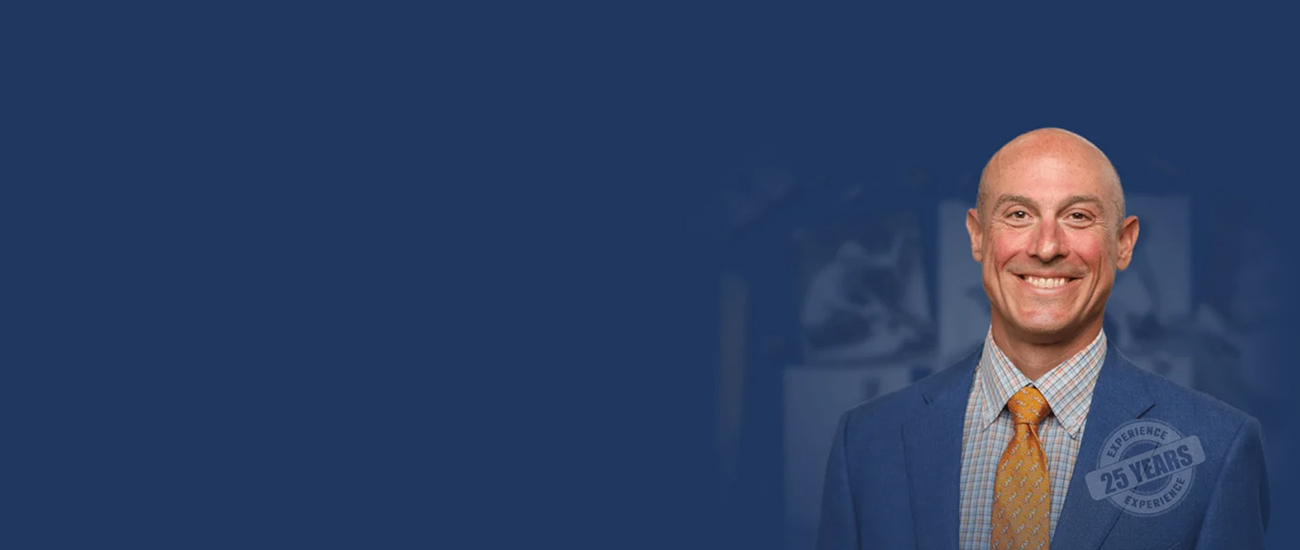- 24/7 Free Consultation: (888) 424-5757 Tap Here To Call Us
Chicago Umbilical Cord Compression Lawyer
Seek Justice in Birth Injury Cases Involving Umbilical Cord Problems
If medical negligence contributed to your child’s birth injury, a Chicago umbilical cord compression lawyer from our team can help you pursue compensation.
Settlements & Verdicts Recovered by Our Chicago Law Firm
Our Chicago birth injury attorney team has successfully handled numerous cases across Illinois, helping families hold medical professionals accountable for negligence that caused lifelong harm to their children.
- $20,300,000 Settlement – Ethan was born at a major Chicago hospital after doctors failed to address clear signs of distress. The delayed delivery caused severe brain injuries and CP, leaving him with lifelong care needs. His family obtained a $20.3 million settlement for medical negligence during labor and delivery.
- $18,355,000 Settlement – At a Southern Illinois hospital, Ava’s delivery was delayed despite repeated warnings of umbilical cord problems and distress. The prolonged labor led to oxygen deprivation and a diagnosis of CP. The $18.35 million settlement reflected her permanent disability and the extensive medical expenses she will face throughout her life.
- $16,433,000 Settlement – Noah suffered brain damage at a Chicago-area hospital after umbilical cord compression went untreated during labor. Despite clear monitoring alerts, the medical team failed to act promptly. His family recovered $16.43 million, accounting for future medical care, lost wages, and the lasting impact of this preventable birth injury.
What Is Umbilical Cord Compression?
Umbilical cord compression occurs when pressure on the baby’s umbilical cord reduces blood and oxygen flow before or during birth. This can happen when the cord wraps around the baby’s neck (nuchal cord), becomes compressed in the birth canal, or is affected by too much or too little amniotic fluid.
A compressed cord can cause decreased fetal movement, abnormal heart rate patterns, and oxygen deprivation, leading to brain damage or other injuries if not properly managed. While mild compression may resolve on its own, prolonged or severe cases require medical intervention.

Why Is Timely Diagnosis Crucial?
Early detection of umbilical cord compression is essential to prevent oxygen deprivation and severe injuries. Immediate medical intervention—such as repositioning the mother, administering oxygen, or performing an emergency cesarean section—can help relieve pressure on the cord and restore oxygen supply.
What Are the Causes and Risk Factors of Umbilical Cord Complications?
Umbilical cord compression can occur due to various complications during pregnancy and the labor and delivery process.
Certain risk factors increase the likelihood of a compressed umbilical cord, making it essential for medical professionals to monitor both mother and baby properly. When negligence delays intervention, the risk of brain damage, organ failure, or even death rises.
Umbilical Cord Prolapse
A prolapsed cord occurs when the umbilical cord slips through the birth canal before or alongside the baby during delivery. This can cause the cord to become compressed between the baby’s head and the mother’s uterus, cutting off blood and oxygen supply.
Prolapse is a medical emergency that requires immediate action, such as an emergency C-section, to prevent brain damage or stillbirth.
Nuchal Cord (Cord Around the Neck)
A nuchal cord happens when the umbilical cord wraps around the baby’s neck one or more times. While some babies are born with a nuchal cord without complications, in severe cases, the cord can tighten, restricting oxygen and blood flow.
If a nuchal cord is not detected and managed properly, it may cause decreased movement or long-term neurological damage.
True Knots in the Umbilical Cord
A true knot forms when the baby moves in a way that causes the umbilical cord to twist into a tight knot. While some knots remain loose and do not cause harm, a tight knot can block blood flow, depriving the baby of oxygen and nutrients.
If left undetected, true knots can lead to brain damage or even death. Proper monitoring is crucial for identifying and addressing this risk.

Oligohydramnios (Low Amniotic Fluid)
Amniotic fluid surrounds the baby, providing cushioning and allowing free movement. If there is too little amniotic fluid (oligohydramnios), the umbilical cord is more likely to become compressed due to a lack of cushioning.
Other Contributing Factors
Additional factors that may increase the risk of umbilical cord compression injuries include:
- Multiple fetuses (twins or triplets) – Increased crowding in the womb can lead to cord entanglement.
- Abnormal fetal presentation – Babies in breech or transverse positions are at a higher risk of cord compression.
- Prolonged labor – Extended pressure on the umbilical cord during a long delivery process can restrict oxygen flow.
What Are the Signs and Symptoms of Umbilical Cord Compression?
Umbilical cord compression can restrict oxygen and blood to the baby, leading to serious birth injuries if not promptly addressed. Medical professionals must monitor for warning signs and take immediate action to prevent harm. If left untreated, prolonged cord compression can result in brain damage, organ failure, or even death.
Fetal Heart Rate Abnormalities
One of the earliest indicators of umbilical cord compression is an irregular baby’s heart rate on a fetal monitor. Warning signs include:
- Variable decelerations – A sudden drop in the baby’s heart rate, often caused by a compressed umbilical cord.
- Bradycardia – A slow heart rate indicating reduced oxygen supply.
- Tachycardia – An abnormally fast heart rate, which may signal lack of oxygen.
Decreased Fetal Movement
A baby’s movement is an essential indicator of well-being. Cord compression may reduce the baby’s ability to move freely, leading to:
- Less frequent kicks or movements;
- Weaker fetal activity compared to normal patterns.
Visible Cord Prolapse
In cases of umbilical cord prolapse, the umbilical cord slips through the birth canal before delivery. A prolapsed cord may be visible outside the vagina or felt during a physical exam.
This is a medical emergency that requires immediate intervention, such as repositioning the mother or performing an emergency cesarean section, to prevent oxygen deprivation and umbilical cord birth injuries.
Signs of Fetal Distress
A baby experiencing prolonged umbilical cord compression may show signs of distress, including:
- Meconium-stained amniotic fluid (baby passes stool before birth, signaling distress);
- Abnormal levels of carbon dioxide due to restricted breathing;
- Low oxygen saturation in fetal monitoring results.
What Are the Potential Injuries Resulting from Umbilical Cord Compression?
When the umbilical cord becomes compressed, it can lead to serious birth injuries. If the pressure on the cord is not relieved in time, the baby may suffer from oxygen deprivation, which can cause brain damage, neurological disorders, or long-term developmental issues.
Medical professionals must act quickly to monitor and respond to signs of distress properly. When negligence delays intervention, families may have legal grounds for a lawsuit.
Hypoxic-Ischemic Encephalopathy (HIE)
Hypoxic-ischemic encephalopathy (HIE) is a severe form of brain injury caused by oxygen and blood deprivation before, during, or after birth. Without enough oxygen, brain cells begin to die, leading to long-term complications such as:
- Cognitive impairments (difficulty with memory, attention, and learning);
- Motor skill deficits (problems with movement, coordination, and balance);
- Seizures due to brain dysfunction;
- Increased risk of CP and developmental delays.
HIE often requires lifelong medical care, therapy, and specialized education.
Cerebral Palsy
Cerebral palsy is a neurological disorder that affects muscle control, movement, and coordination. It is one of the most common birth injuries linked to oxygen deprivation caused by umbilical cord compression. Babies with CP may experience:
- Muscle stiffness or weakness;
- Difficulty walking or maintaining balance;
- Trouble with fine motor skills (such as grasping objects);
- Speech and swallowing difficulties.
While treatments such as physical therapy, occupational therapy, and assistive devices can help manage symptoms, CP is a lifelong condition.

Developmental Delays
Lack of oxygen and blood flow during birth can interfere with a baby’s brain development, leading to developmental delays. A child may experience:
- Delayed speech and language development;
- Difficulty sitting up, crawling, or walking;
- Problems with problem-solving and critical thinking.
Early intervention, including speech and occupational therapy, can help improve developmental outcomes, but some children may face long-term challenges.
Other Neurological Impairments
In addition to HIE, CP, and developmental delays, umbilical cord compression injuries can lead to:
- Seizures caused by abnormal brain activity;
- Learning disabilities that impact reading, writing, and math skills;
- Behavioral and emotional challenges, such as ADHD or anxiety.
When negligence contributes to umbilical cord birth injuries, families may be entitled to compensation for medical costs, therapy, and long-term care. An experienced Chicago medical malpractice lawyer can help families explore their legal options.
Does Umbilical Cord Compression Constitute Medical Negligence?
Medical professionals are expected to uphold a high standard of care in Chicago hospitals and medical facilities. When an umbilical cord becomes compressed, doctors, nurses, and other healthcare providers must act quickly to prevent oxygen deprivation and potential birth injuries.
Failure to monitor the baby, recognize warning signs, or intervene appropriately can lead to serious complications, including brain injury or even death. When these mistakes occur, families may have grounds for a birth injury lawsuit based on negligence.
Failure to Properly Monitor Fetal Heart Rate
Medical professionals should use continuous fetal monitoring to detect signs of umbilical cord compression, such as:
- Variable decelerations – Sudden drops in the baby’s heart rate;
- Bradycardia – A dangerously slow heart rate;
- Tachycardia – A rapid heart rate.
Delayed or Improper Response to Fetal Distress
If a baby is in distress due to a compressed umbilical cord, doctors must respond quickly to relieve pressure and restore oxygen flow. Depending on the severity, this may involve:
- Repositioning the mother to reduce compression;
- Administering oxygen to increase the mother’s oxygen levels;
- Amnioinfusion (saline solution through the uterus) to provide cushioning for the cord;
- Emergency cesarean section (C-section) if distress continues.
Failure to Diagnose and Treat Underlying Conditions
Certain risk factors increase the likelihood of umbilical cord compression. Doctors should diagnose and manage conditions that can lead to complications, such as:
- Too much amniotic fluid (polyhydramnios), increasing the risk of prolapse;
- Oligohydramnios (low amniotic fluid), making it easier for the cord to become compressed;
- Multiple fetuses, increasing the chance of cord entanglement;
- Abnormal fetal positioning, such as breech presentation, may put pressure on the umbilical cord.
Improper Use of Labor-Inducing Drugs
Medications like Pitocin are often used to induce or speed up labor, but they must be administered carefully. Overuse of labor-inducing drugs can cause:
- Extreme contractions compressing the umbilical cord;
- Decreased blood and oxygen supply;
- Increased risk of emergency interventions, such as C-sections.
Hospitals and doctors in Chicago are expected to meet strict medical standards to protect mothers and babies’ health. When they fail to uphold this standard of care, families may have the right to pursue a birth injury lawsuit.
A skilled Chicago birth injury lawyer can investigate whether negligence played a role in your child’s injuries and help you seek maximum compensation for medical costs, therapy, and long-term care.

How Our Birth Injury Lawyers in Chicago Can Help
When umbilical cord compression is not properly managed, the consequences can be devastating. Families facing the lifelong medical and financial burdens of these birth injuries should not have to bear the costs alone, especially when negligence is to blame.
If medical professionals fail to properly monitor your baby’s condition, delay treatment, or mismanage birth complications during the labor and delivery process, they may be liable for medical malpractice. Filing a birth injury lawsuit can:
- Secure compensation for medical bills, therapy, and future care;
- Hold negligent doctors and hospitals accountable for failing to meet the expected standard of care;
- Provide financial relief for necessary home modifications, assistive devices, and special education;
- Help ensure other families don’t suffer the same preventable mistakes.
What Is the Average Umbilical Cord Compression Birth Injury Claim in Chicago?
According to Law.com’s VerdictSearch, the average award for cases involving umbilical cord compression injuries is approximately $12.93 million, with reported case values ranging from $500,000 to $30 million.
Several factors affect the value of a medical malpractice lawsuit involving newborn seizures:
- Severity of the child’s birth injury: Claims involving permanent neurological damage caused by birth asphyxia are valued higher due to the child’s long-term care needs.
- Evidence of medical negligence: Higher-value cases typically show that medical professionals failed to monitor signs of distress, delayed delivery, or misused birthing tools, contributing to the injury.
- Type and duration of seizures: Seizures that result from prolonged oxygen deprivation often indicate severe brain trauma, increasing compensation.
- Future medical expenses: Expert-supported life care plans showing the need for 24/7 care, physical therapy, medications, and assistive technology contribute significantly to the award size.
- Impact on the child’s quality of life: A child’s ability to walk, speak, or live independently directly influences the value of a birth injury claim.
- Lost wages and earning capacity: If a child suffered permanent impairment, the projected loss of future income is factored into the final settlement or verdict.
Example Cases
$12 Million Settlement – Delayed C-Section Causes Brain Damage
Brandon Jones was delivered at Provena St. Therese Medical Center in Waukegan after fetal monitors showed variable decelerations consistent with umbilical cord compression. Nurses failed to notify the attending physician in time, delaying an emergency C-section.
Brandon suffered severe brain damage and CP, leaving him unable to walk or talk. His family alleged that the delay in delivery caused his injuries. Though a jury awarded $23.3 million, a high–low agreement limited recovery to $12 million, covering future medical costs and lifelong care.
$10.25 Million Settlement – Failure to Respond to Fetal Distress Leads to Cerebral Palsy
Aaron Garcia was born at Edward Hospital in Chicago after medical staff failed to respond to signs of distress and reduced blood supply. The attending physician left for another procedure while Aaron’s heart rate declined, delaying the emergency C-section.
The delay caused oxygen deprivation and CP, leaving Aaron unable to walk or talk. The jury awarded $12.5 million, later reduced to $10.25 million through a high–low agreement. The compensation addressed his life care needs, lost earnings, and future medical costs.
$9.5 Million Settlement – Mismanaged Delivery Results in Quadriplegia
Patrick O’Came was delivered at Sherman Hospital in Elgin, where umbilical cord compression caused severe drops in fetal heart rate. A nurse-midwife applied fundal pressure instead of initiating emergency resuscitation or requesting a physician’s help, restricting oxygen to the baby.
Patrick suffered permanent brain injury and quadriplegia, requiring round-the-clock care. The lawsuit claimed failures in supervision and hospital policies. The case resolved for $9.5 million, covering 24-hour attendant care, speech therapy, and lifelong medical support.
$1.75 Million Settlement – Delayed C-Section After Vasa Praevia Causes Fatal Oxygen Deprivation
Joshua Kraeger was delivered at Advocate Good Shepherd Hospital in Barrington after staff failed to act on fetal heart monitor readings showing severe decelerations and umbilical cord compression.
Doctors delayed performing a C-section, allowing prolonged oxygen deprivation from vasa praevia, a condition that compromised blood flow. Joshua was born with anoxic brain damage and died three days later. His estate reached a $1.75 million settlement for wrongful death, covering medical costs and loss of society for his family.
What Laws Govern Umbilical Cord Compression Cases in Illinois?
Under Illinois medical malpractice laws (735 ILCS 5/2‑622), anyone filing a lawsuit must include an affidavit and a written report from a qualified medical expert. The report must state that the claim has merit and is based on a review of medical records and evidence.
735 ILCS 5/13-212 limits the time families have to file a birth injury claim. In Illinois, most medical malpractice actions must be filed within two years of discovering the injury, but no later than eight years after the negligent act for minors.
In the case of LeBron v. Gottlieb Memorial Hospital, the court struck down statutory caps on non-economic damages in medical malpractice cases, ruling them unconstitutional. The decision allows families affected by birth injuries to pursue full recovery for pain, suffering, and loss of normal life without arbitrary limits on compensation.
Secure Expert Legal Counsel!

Our birth injury attorneys have successfully handled numerous lawsuits, helping families recover compensation for preventable birth injuries.
Our Chicago personal injury lawyers work with medical experts to review records, determine liability, and build a strong case against negligent healthcare providers. We work on a contingency fee basis, meaning you pay nothing unless we win your case. To schedule a free consultation, call us at (888) 424–5757 or fill out our contact form.
All content undergoes thorough legal review by experienced attorneys, including Jonathan Rosenfeld. With 25 years of experience in personal injury law and over 100 years of combined legal expertise within our team, we ensure that every article is legally accurate, compliant, and reflects current legal standards.







